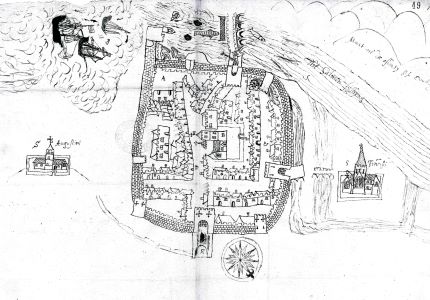Old Galway
MEDIEVAL GALWAY

by Tom Kenny
This very stylized plan of Galway was made in 1583 by Barnaby Googe and is the earliest surviving map of the city. It shows the walled town as it stood at the end of the medieval period. Galway was packed with houses: the D-shaped circuit of walls with mural towers and gates was complete; there was only one bridge over the fast flowing river, which was also an important salmon fishery and it possessed a wharf or landing place for ships. The Parish Church of St. Nicholas and the central market place with its market cross were prominent in the townscape, which was structured around the north-east/south-west axis of Shop Street branching into Main Guard Street and High Street/Quay Street.
DRUID, 40 YEARS IN THE LANE

by Tom Kenny
Druid Theatre Company was founded in May, 1975 with the initial aim of providing theatre entertainment for tourists in Galway. They opened with three full length plays on successive nights in the Jesuit Hall. The season was a success so they made the very brave decision to operate the company on a full-time basis. Their productions were presented on a fit-up basis as were a number of lunch time shows in the Fo’Castle in Dominick Street. They converted this latter venue into a fully equipped pocket theatre seating 47 people. It was a popular venue, well supported but there were problems with regard to backstage, storage and office space.
Cloran’s Cross

by Tom Kenny
In May, 1846, as part of a Famine relief project, 175 people were employed to build a road linking Dangan to Salthill. Part of that road was known as Bóthar na Mine (the Road of the Indian Meal ) because all of the wages were used to buy oatmeal. I have never been able to find out how, when, or why this name was translated into English as Threadneedle Road.
The Piscatorial School

by Tom Kenny
Living conditions were very bad in the Claddagh during the Famine. Most people there made their living from the sea but they refused to adapt to new and more effective fishing techniques which would have improved their catches, and so their income was affected and poverty ensued. Most of the fishermen there had put their nets in hock just to keep their families alive. Equally, Claddagh people were opposed to education, as their sons would grow up to be fishermen, they felt no need to send them to school.
The Docker's Rugby Team

by Tom Kenny
Galway Rovers Rugby Football club first played competitively in 1899. In 1907, they won the Connacht Junior Cup, which had been presented two years previously to the Union by Professor Alfred Senior. The club disbanded after that, probably during World War 1, but it was revived by a man named John L. Sullivan in 1931.
THE SPANISH ARCH FROM LONG WALK

by Tom Kenny
Long Walk was originally built as a wall by the Eyre family in order to construct a mud berth. Among those who lived there around the time this photograph was taken were Tom Gannon, Sarah O’Donnellon, Mrs. Hosty and Pateen Green. There was an entry through a large archway into a courtyard known as Green’s Alley and the five houses there were occupied by the Andersons, McDonaghs, Canavans, Gorhams and Finnertys. A Mrs. McDonagh lived next door in a building known as ‘The Hall’ and further on lived Mrs. Lee, John Folan, Bideen Joyce, Ella McDonagh, Mrs. Folan and Mike Walsh.
A Pig Fair in Eyre Square

by Tom Kenny
Hely Dutton, in his survey of County Galway in 1824 wrote “In every considerable town there is a market for fat cattle and sheep once a week. The earliest cattle fairs in Galway were held at Fairhill (hence the name) but in the 19th century, they moved to Eyre Square. It was where the farmer sold his product to other farmers, to butchers and to visiting dealers. It was where town and country met, where the rural people would come to town to sell, then buy whatever necessities they needed before returning home.
Salthill Post Office

by Tom Kenny
In 1851, a sub-post office opened in Salthill where the Bal pub is today. In 1859, Salthill was brought within the town postal area. In those early days, the post was delivered on foot. The first bicycle postal delivery was in 1901. From 1914 to 1926, Michael O’Flaherty of Dominick Street and Mike Ruane of Henry Street had a horse and van which they used to deliver letter and parcel post to the Salthill area.
.png)